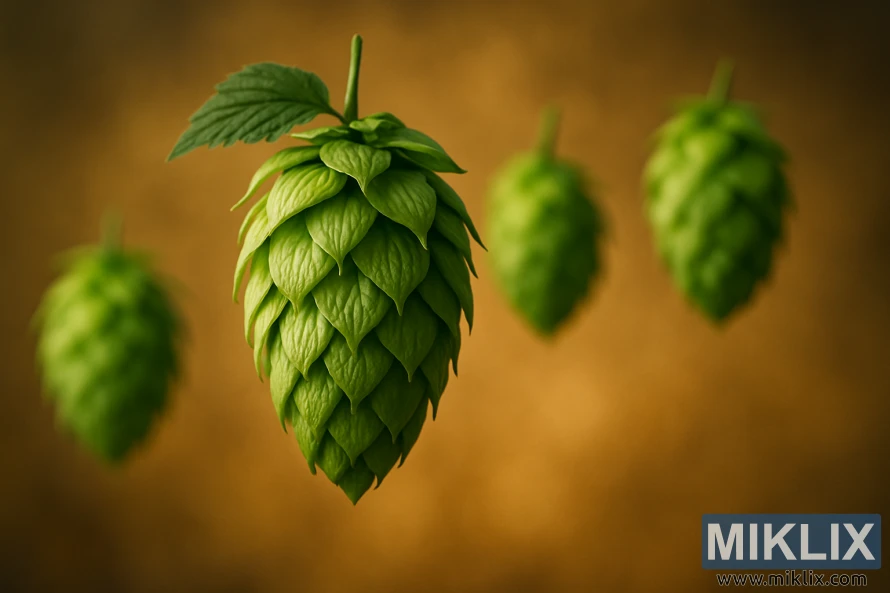Image: Pride of Ringwood Hops
Published: August 18, 2025 at 7:45:50 AM UTC
Last updated: September 26, 2025 at 9:00:54 PM UTC
A close-up of Pride of Ringwood hops in golden light, showcasing their vibrant cones and textures, symbolizing their role in artisanal beer brewing.
Suspended as though caught in a moment outside of time, the Pride of Ringwood hop cones appear almost weightless, their green bracts layered in delicate, overlapping scales that glisten softly under the golden glow of diffused light. The foremost cone hangs prominently in sharp focus, each leaf-like bract curling outward with a quiet elegance, revealing the intricate patterns that define the anatomy of this iconic Australian hop. Its verdant hue contrasts vividly against the warm, honeyed backdrop, creating a composition that feels at once natural and carefully staged, as though nature itself were presenting these hops as objects of both beauty and utility. Behind it, slightly blurred in the shallow depth of field, three additional cones hover in harmonious balance, their forms echoing the central specimen while fading gently into soft abstraction. This interplay of clarity and blur draws the viewer’s gaze directly to the fine details of the leading cone—the subtle textures, faint veins running through each bract, and the suggestion of lupulin nestled deep within.
The lighting enhances the sense of reverence, casting a gentle radiance over the scene that recalls the golden hour of a summer evening in the hop fields. Yet here, instead of being bound by soil and trellis, the cones seem to float freely, liberated from their bines, as if elevated to the status of rare treasures or artifacts. This ethereal presentation underscores the cultural and artisanal significance of Pride of Ringwood, a hop that has left a lasting imprint on brewing history. Its reputation as a variety that imparts robust bitterness and distinct spicy, resinous notes is subtly suggested by the visual strength of its cone—compact, resilient, and richly hued. The background, rendered in warm, earthy tones of amber and brown, reinforces the connection between these hops and the soil from which they sprang, reminding the viewer that their journey from field to brewery is one of both grounded tradition and creative transformation.
There is a quiet narrative embedded in the composition, one that celebrates not only the physical form of the hops but also the sensory experiences they promise to deliver. The sharp foreground focus invites the viewer to imagine the tactile feel of the cone—its slightly papery exterior, the faint stickiness of resinous oils, and the fragrance released when the bracts are rubbed between the fingers. The blurred background cones, meanwhile, evoke abundance, hinting at entire harvests of Pride of Ringwood cultivated for generations in the fertile valleys of Victoria, Australia. Their presence suggests continuity, legacy, and the communal effort of growers and brewers who have preserved and perfected this variety over decades.
The overall mood of the image is contemplative, almost reverent, elevating the hop cone from a simple agricultural product to a symbol of craftsmanship, flavor, and cultural heritage. By isolating the cones in midair and enveloping them in golden light, the composition bridges the gap between science and art, farming and brewing, tradition and innovation. It becomes a portrait not just of Pride of Ringwood as a plant, but of its identity as an essential ingredient in the alchemy of beer—a reminder that within these small green cones lies the power to shape taste, evoke memory, and connect people across time and place through the shared ritual of brewing and drinking.
The image is related to: Hops in Beer Brewing: Pride of Ringwood

